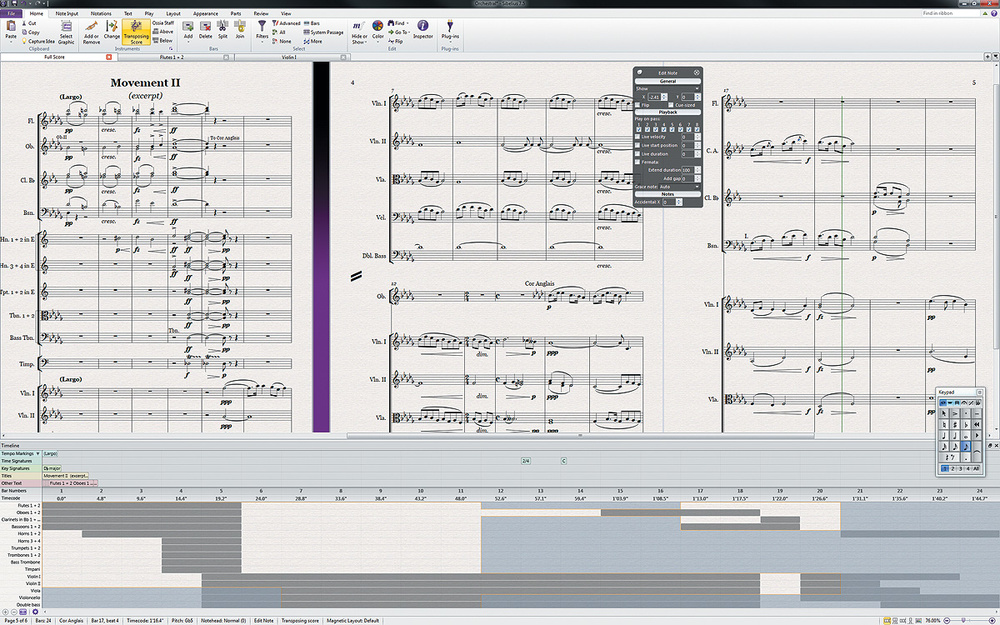

Click the first notehead and then hold down CTRL (Command on Mac) and click on the other notehead(s). TIP: You can select more than one note at a time to add the + or 0 marking.
Select the notehead and use the 4th Keypad Layout (Articulations) to add the + for closed and the 0 for open. Enter the hi-hat notes as you want them to play back. Since I often play in the notation from a MIDI keyboard, I delete and open notehead from the drum map leaving just the one with the o articulation over it for open hi-hat. However, if you are entering with the mouse or computer keyboard, you have to manually assign the articulations to the notes. In Sibelius, if you play in the open and closed hi-hat from a MIDI instrument, the notehead will be changed automatically and since the X and open notehead occur first in the map, they will appear. You must enter the appropriate hi-hat sound as they are being entered. It is important to realize that in Finale, the + and o articulations are for visual purposes only. While holding down the letter click on the note to assign the articulation: open (o) and closed (+). With the Articulations tool selected, hold down the letter “I” for = or the letter “O” for open. TIP: Use the metatool assigned to these markings for faster entry. Choose the + for closed or the o for open. I enter the proper hi-hat sound and then go back and add the articulations to the notes: + for closed and o for open.Īfter entering the notation for the hi-hat, add the + and o to the noteheads by: In Finale the drum set map has both the open and closed hi-hat assigned to the same X notehead. In Sibelius, the drum set map includes both a different notehead for open and closed hi-hat and the articulations. This can cause problems when there is a half note in the hi-hat as the circled X is the same notehead used for half and whole notes. In Finale, this requires that you go into the drum map and change the notehead assigned to the open hi-hat from an X to a circled X. The other option is to use a different notehead for open hi-hat and an x for closed hi-hat. Usually, if there is a closed sign, you don’t have to put it on every note, just after an open sign is used. The most common is to use the articulations + for closed and o for open. There are two ways that open and closed hi-hat is typically notated. Here is the link to the quickstart video: SIBELIUS ULTIMATE VS SIBELIUS MANUAL
Sibelius 7 starts on page 352.įinale: Go to Help > User Manual and search for Drum Maps. From the index go section 4.13 Percussion. Sibelius: go to Help > Reference and read the section on Drum Maps. If you are new to drum maps, read about them in the documentation. Drum maps are needed since percussion instruments have multiple sounds and noteheads assigned to the same line or space in a part. Oh, and I think that the default notation in Sibelius just looks better (as do my performers).In this post, I will go through the steps to notate open and closed hi-hat indications in drum set parts in Finale and Sibelius.īoth Finale and Sibelius use a drum map for percussion parts. In Sibelius, it will automatically put it in its default, but that is easily changed to make the score look how I want it to. I always feel that when using Finale, I'm being forced into their default style of notation. Granted, the fact that it is easily turned off basically sums up the main reason that I prefer Sibelius. Yes, it has its moments when you have to turn it off, but even then it solves many more problems than it has ever created. Oh, and magnetic layout is absolutely amazing.

I understand the notion of the tool based system that Finale uses, but it is somewhat frustrating to have to first find the right thing in the Special Tools pallet, then click the little box that obscures the actual symbol, then rinse and repeat every time I want to adjust the location of the beams. Basically, I prefer Sibelius because I feel that the score come out looking better, it is easier to make custom edits, and it is much more accessible.

#1 So, I figured I'd bring the musician's debate to team liquid.







 0 kommentar(er)
0 kommentar(er)
